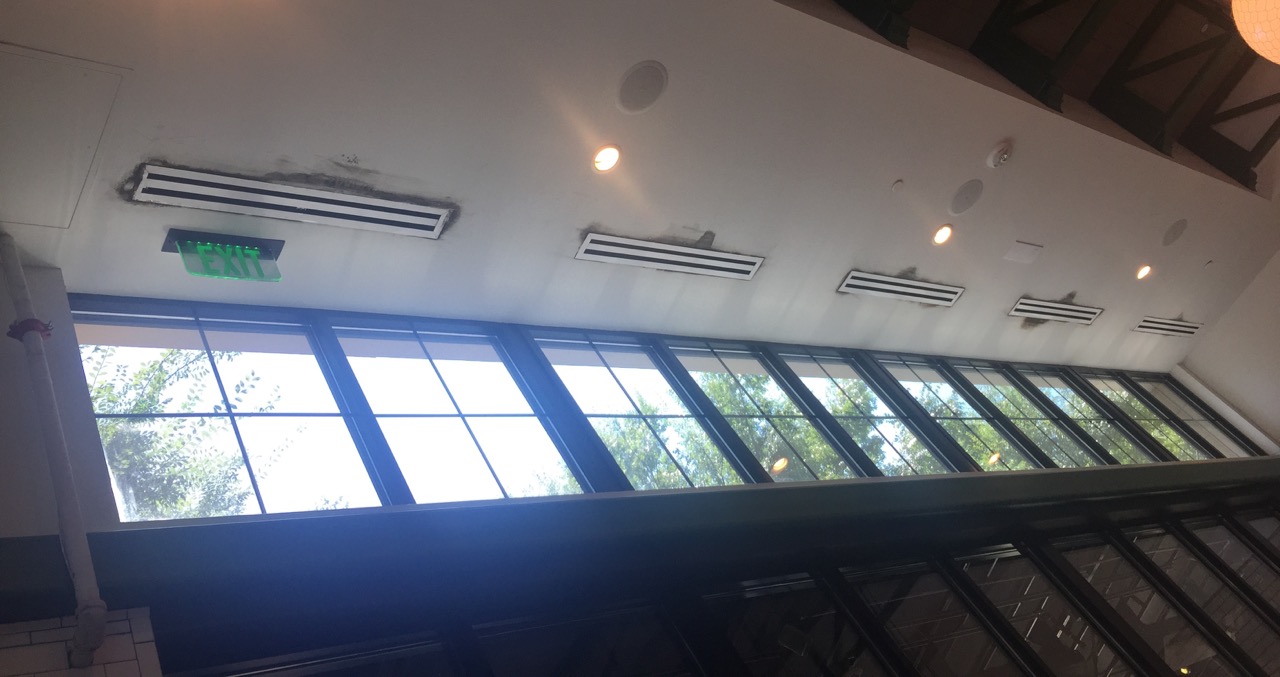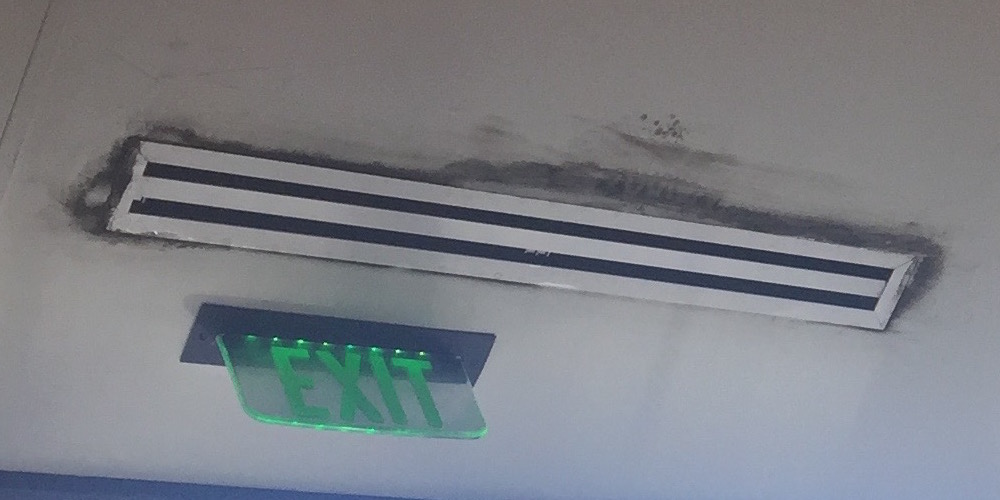What’s Causing the Moisture Problem in This Trendy Restaurant?

I’ve got the curse, you know. I can’t walk into a building and not check out what’s going on with ductwork, windows, and anything else that lets me apply what I know about building science. Yesterday, I went to lunch at a trendy restaurant near Emory University and of course looked up at the ceiling. You can see what caught my attention in the photo above. The restaurant is only three or four years old, so I’ve been watching this problem get worse for a while now. I have some ideas about what’s happening here. Do you?
The clues
Before we get into the speculation part, though, let’s lay out the facts of the case. First, those are supply diffusers for the air conditioning system. They’re in a bulkhead over the windows on an exterior wall. The dark areas around the diffusers have been growing over the past few years. It’s hard to tell what those dark areas are, but it’s probably either dirt or some kind of microbial infestation (e.g., mold).
It looked like there were a few drops of condensation on the diffuser closest to our table, which I’ve shown in closeup below. I didn’t really see much on the others in that row of diffusers by the windows. The outdoor weather yesterday was fairly dry, with a dew point of about 61° F.
Another set of diffusers near the kitchen, however, was covered with condensation. Unfortunately, I didn’t take a photo of those diffusers, but they didn’t have as much discoloration on the drywall surrounding the diffusers. More drops of water on the metal; less darkness.

Finally, the indoors was at a really high negative pressure. As I left the restaurant, I had to push really hard to open the door.
Hypotheses
OK, let’s see if we can come up with a reasonable hypothesis as to the causes of the moisture problems here. First, where is the moisture coming from? One obvious potential source is the kitchen. Cooking produces a lot of moisture. The diffusers nearer the kitchen being covered with condensation supports the idea of moisture from the kitchen.
But with all that negative pressure, how would any moisture escape from the kitchen? And why would the diffusers in the bulkhead on the exterior wall have more discoloration? Let’s take the questions in order.
Just having really strong exhaust hoods pulling a lot of air doesn’t mean all the moisture and contaminants get pulled in. There’s this thing called capture efficiency. It’s a measure of how much of the stuff coming off the range or out of the ovens gets pulled into the hood. Lawrence Berkeley National Lab is doing work on this topic so maybe someday we’ll be able to select hoods based not only on how many cubic feet per minute they pull but also their capture efficiency.
Restaurant exhaust hoods probably have better capture efficiency than what you have in your home, but I didn’t get a look in there to see what theirs looks like. There’s a lot going on in restaurant kitchens and even if the hood does a good job capturing the stuff coming off the range, cooks move steaming dishes around and dishwashers also put out moisture. So, it’s certainly possible that at least some of the moisture is coming from the kitchen.
But the bulkhead diffusers don’t have as much hanging condensation and they have more discoloration. I think the moisture there is coming from above. Even with a decent air barrier, the strong negative pressure in the restaurant could be pulling outdoor air into the bulkhead. If the ducts or boots (the metal part that the diffusers attach to) aren’t well insulated, the water vapor from the outdoor air is likely to condense on their surfaces. That water drips down to the drywall, keeps it wet all summer, and the result is the discoloration you see. Using zonal pressure diagnostics, we could measure the pressure inside the bulkhead with and without the exhaust fans running to test this hypothesis.
Another possibility is that the conditioned air is too cold and all the moisture is coming from indoors. Maybe the diffusers near the kitchen had more condensation just because they were closer to the air handler and the air was colder when it got there. The discoloration in the drywall would come from water on the diffusers wicking into the drywall. I don’t think this is the answer, though, because the bulkhead diffusers had more discoloration, which tells me the water is coming from above over there.
Potential fixes
The first thing I’d fix in this restaurant would be the negative pressure. Commercial buildings are required by code to have makeup air, but this one clearly doesn’t have enough. Adding makeup air and reducing the negative pressure may completely solve the problem with the bulkhead diffusers. It may even solve the problem with the other diffusers if the moisture there is coming from outdoors, too.
If the zonal pressure diagnostics indicates an air leakage problem in the bulkhead and adding makeup air doesn’t solve it, then the air barrier is going to have be tightened up there. I’d want to get rid of that drywall anyway because who knows how bad the problem is above.
If the air temperature from the AC turns out to be too low, the air conditioning system needs to be checked to find out why. That should be an easy fix.
All buildings tell a story. This one is issuing a cry for help.
Related Articles
Solving a Crawl Space Water Mystery
The Mystery of the Ventilating Dehumidifier
Buried Ducts Risk Condensation in Humid Climates
NOTE: Comments are moderated. Your comment will not appear below until approved.
This Post Has 13 Comments
Comments are closed.

Nice job Allison! This is a
Nice job Allison! This is a hard concept to unpack and teach, yet you’ve done it in about a page. I’m bitlinking this – http://bit.ly/NoMakeupAir
We diagnose this condition on
We diagnose this condition on occasion. A quick way to assess the negative pressure condition is to visit the doorway between kitchen and dining room. With the door mostly closed, check for air moving from dining room to kitchen. It is common that the makeup air system not be as effective as the exhaust system – check for clogged intake screens.
Don’t look to the kitchen staff to report on this real quick…the more nice cool air comes in from the dining room, the happier they are.
I’ll take a shot.
I’ll take a shot.
The building is old and therefore very leaky so due to a lack of make up air the commercial exhaust fans are sucking in a tremendous amount of exterior moisture laden air through the cracks. This moisture is condensing on the ducts/supply boots hidden in the ceiling.
Perhaps Joseph Lstiburek would say this is a perfect example of why exhaust only ventilation sucks.
😉
Who is going to approach the
Who is going to approach the owner and get paid to fix this issue?
Dr. Allison,
Dr. Allison,
I think your services are needed at the new Falcons Stadium. Apparently there are some leaks from the ceiling and I think may be condensation from these huge HVAC supply vents in the ceiling.
Great article. I do the same
Great article. I do the same thing when I go into buildings. I’ve found many restaurants with oversized AC equipment allowing the humidity to creep up. Also, not enough make up air for the kitchen vent as you discussed.
I like that Allison mentioned
I like that Allison mentioned capture efficiency, which is really important. Restaurants are a complex beast! Balancing the hoods (ranges, dishwasher, ovens) with the HVAC system is always a challenge and rarely ever right. Even if it is balanced, there are so many things in play that can change that equation, kitchen doors left open for example, steam tables, etc.
In this example, it is almost certainly mold growth on the drywall surrounding the diffuser as the drywall becomes more saturated from condensation. Whether the condensation is from the supply ductwork in the chase (bulkhead), which is typically metal for this type of diffuser, or from the bottom of the diffuser, requires more information. My guess is that it is from the top too. Could be outside air infiltration in the chase or poorly sealed diffusers with the ductwork. I favor the latter since the problem exist in a different location with the same type of diffusers. Perhaps less likely, but maybe a contributor, is heat gain from the adjacent windows.
Alison – Nice pix!. I think
Alison – Nice pix!. I think this is unsealed ducts blowing cold air at the wall board, thus condensation (and mold). That’s why you see big spots on just one side of the diffuser (or both). Moist attic air might be entrained to blow on it, too. Fix it by sealing the connection with mastic, then duct tape. It’s probably only got tape which has dried out and let the cold air out.
Great newsletter Dr. Much
Great newsletter Dr. Much like you I find myself looking structures differently now since my first building science seminar only a few years ago. I love summer camp and have had the privilege of attending the last two years. I’m far from an “expert” but as a restorer I inspect
hundreds of buildings each year and see this issue from time to time. I agree with you Dr. The negative pressure you describe can be pulling warm wet air into the conditioned space in a high amount due to leakage, flowing across the cooler surface of the diffuser, air condenses at surface of diffuser because it’s at dew point temperature or below, pools on the surface just enough to touch/wick into drywall and if this condition is on going likely to form some level of microbial contamination in this area. I am amazed how much leakage can negatively affect a building. Thanks for the newsletter and keep running.
I have seen this before and I
I have seen this before and I also thought kitchen heat rising to ceiling registers, but it in my first cases it was only along the windows so that did not fit. Ultimately, I taped about 24 inches of cardboard over the top of the windows and guess what no condensation. Then I thought, just like through car windows hot days cold a.c. and you have condensation on both windows and diffusers. The sunlight was coming through the windows at times during the day and causing intense heat build up along the ceiling near the diffusers and when the cold air was discharging it had the potential for a mini-storm. Now I just close curtains, If available and run a while to check. It can likely be other things, but this is from actual experience.
Drywall never lies , maybe we
Drywall never lies , maybe we use it so that it provides a constant litmus test for building problems for all to see , look for some bright student to build tell tales to visually report this stuff .
I just went to this
I just went to this restaurant today and immediately thought of this post when I saw little table tents saying that condensation is normal in this humid climate and not to worry about drips on your plate. Interestingly, I saw black spots around some of the light fixtures and ceiling sprinklers, which would seem to support your hypothesis of outdoor air entering the ceiling above. Seems it might be worth another visit Allison!
As long as there is a leak in
As long as there is a leak in the cold air between the suspended ceiling and the diffuser, then there will be an condensation for air or maybe there’s problem in insulation of diffusers plenum box.